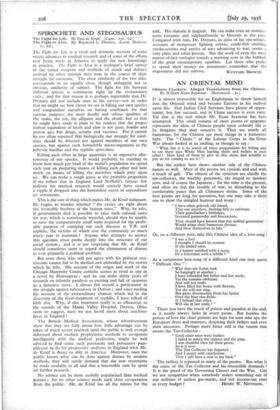SPIROCHETE AND STEGOSAURUS
The Fight for Life. By Paul de Kruif. (Cape. izs. 6d.)
The Fight to Live. By Raymond L. Ditmars. (Lovat Dickson. 8s. 6d.)
The Fight for Life is a vivid and dramatic account of some recent advances in medical research and of some of the efforts now being made in America to apply the new knowledge in practice. The Fight to Live is a zoologist's brief survey of the varied weapons and methods of attack and defence evolved by other animals than man in the course of their struggle for existence. The close similarity of the two titles corresponds to an equally close, though unhappily not so obvious, similarity of subject. The fight for life between different Species is continuous right up the evolutionary scale ; and for that reason it is perhaps regrettable that Dr. Ditmars did not include man in his survey—not in order that we might sec how clever we are at killing our own species and congratulate ourselves on having combined, for that curious purpose, the most deadly and odious qualities of the snake, the ant, the alligator and the skunk, but so that he might have made it plain to his readers that the proper human equivalent of tooth and claw is not guns, bombs and poison gas, but drugs, serums and vaccines. For it cannot be too often repeated that biologically our struggle for exist- ence should be directed not against members of our own species, but against such formidable micro-organisms as the tubercle bacillus and the syphilis spirochete.
Killing each other in large quantities is an expensive idio- syncrasy of our species. It would probably be startling to know how much per head of the world's population we spend each year on preparing means of killing each other and how much on means of killing the microbes which prey upon us. We can make a rough guess at the probable proportion if we reflect that in England Lord Nuffield's famous few Millions for medical research would scarcely have caused a ripple if dropped into the bottomless ocean of expenditure on armaments.
This is the sort of thing which makes Mr. de Kruif indignant. He begins to wonder whether " the cynics are right about the invincible boobery of the human mass." Why, .he asks, if _governments find it possible to raise such colossal sums for war, which is notoriously wasteful, should they be unable to raise the comparatively small sums required for the profit- able purpose of stamping out such diseases as T.B. and syphilis, the victims of which cost the community so much every year to maintain ? Anyone who attempts to answer this question must probe deeply into the structure of our social system ; and it is not surprising that Mr. de Kruif should sometimes seem to regard the elimination of disease as now primarily a political problem.
But even those who will not agree with his political con- clusions cannot fail to be thrilled and enthralled by the stories Which he tells. His account of-the origin and work of the Chicago Maternity Centre contains scenes as vivid as any in a novel by Hemingway ; and he can make thirty years of research on infantile paralysis as exciting and full of suspense as a detective story. I almost felt myself a participator in the struggle against tuberculosis in Detroit ; and since reading lira account of the extraordinary chances which led to the discovery of the fever-treatment 'of syphilis, I have talked of little else. Why, if this treatment really is as efficacious as the records of the Miami Valley Hospital, Dayton, Ohio, seem to suggest, have we not heard more about machine- ever in England ?
The British Medical Association, whose advertisements show that they are fully aware how little advantage can be taken of much recent research until the Public is well enough informed about modern prophylactic methods to co-operate intelligently with the medical profession, might be well advised to find some such passionate and persuasive pam- phleteer to do for progressive medicine in England what Mr. de Kruif is doing so ably in America. Moreover, once the public knows. what can be done against disease by modern Methods, they will surely demand that the new treatments be made available to all and that a reasonable sum be spent on further research.
No science can be more usefully popularised than medical science ; for no other science needs such close co-operation from the public. Mr. de Kruif- has all the talents for the
taik. His rhetoric is magical. He can Make even an atomizer seem romantic and sulphanilamide to blossom as the rose. Compared with him, Dr. Ditmars, in spite of his eye-witness accounts of mongooses fighting cobras, cuttle-fish emitting smoke-screens and armies of ants advancing to war, seems- a vety plain and snber:Person. But the work of even the most matter-of-fact zoologist sounds a warning note in the hubbub of the great contemporary squabble. Let those who prefer to spend their money on armaments remember that du§


































 Previous page
Previous page